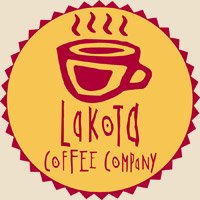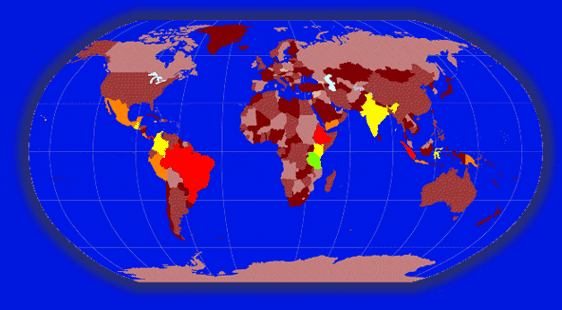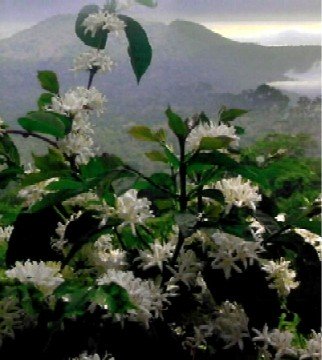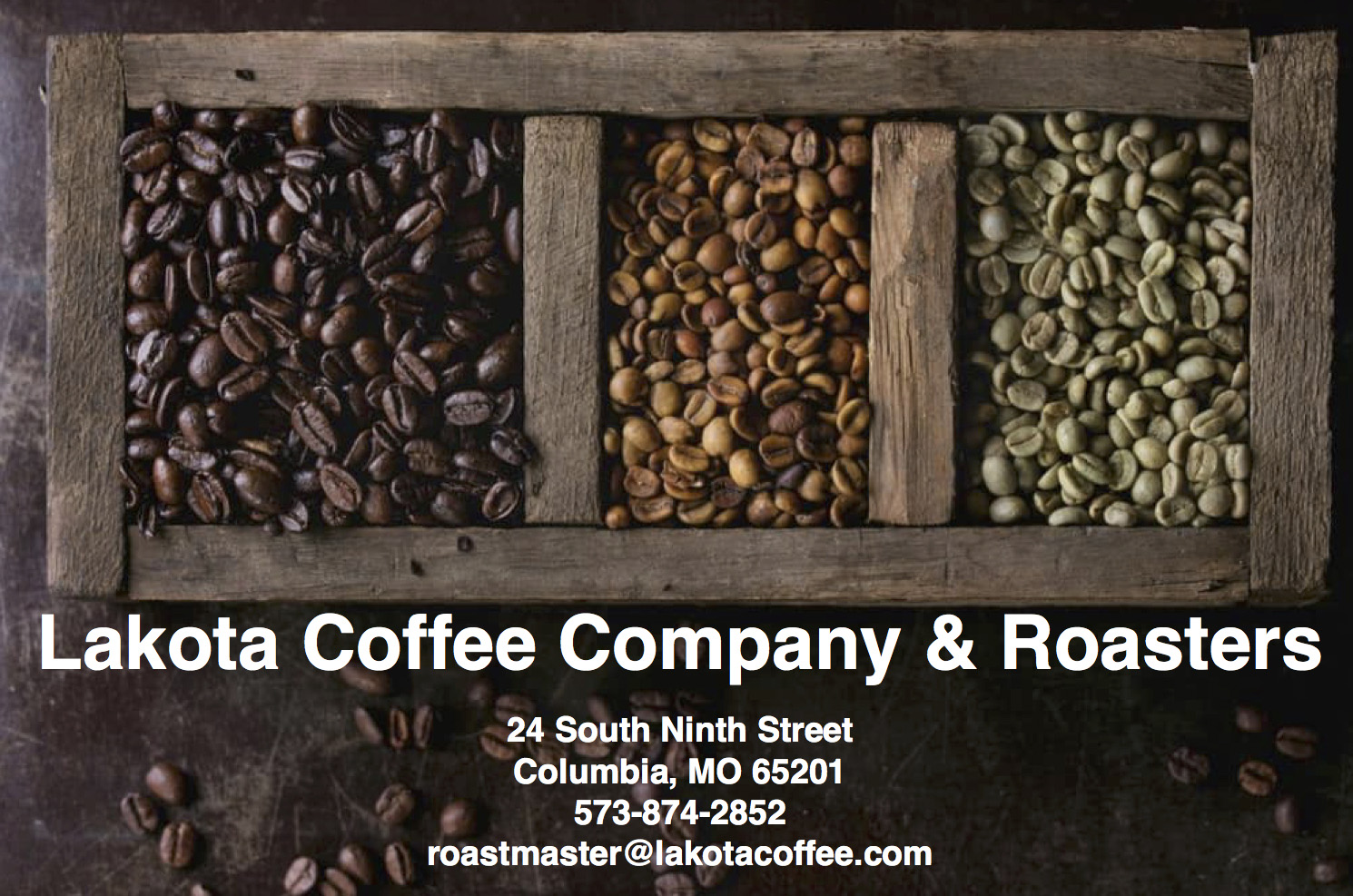
EXPLORE THE COFFEES OF THE WORLD
DO YOU REALLY KNOW
HOW GOOD COFFEE CAN BE?
Now you can explore the Coffees of the World through the experience of a professional coffee Roastmaster, a long time coffee roasting company owner, and one of the best coffee importers in the business!

F.A.Q. Section Coffee Description Pages Contact Us!
AAAHHH! What makes the Coffees of the World what they are?
What makes them taste so different and unique? If the coffee beans are beautiful to look at, and a nice deep golden brown, does that guarantee great flavor and a shot at “the perfect cup”?
Well, one way to put all the confusion aside about coffee grading and fancy coffee labels is to find a Coffee Roasting Company (Ahem, I just happen to know of one!) that guarantees the quality of the green coffee they get from their trusted coffee importer.
That way, regardless of what exotic name may be on the bag, you can safely rest assured that you are purchasing a coffee that has been "cupped" by experts and purchased strictly for its quality “in the cup”.
A good roasting company will provide an iron clad quality guarantee, you know, your money back if not absolutely satisfied. They can afford to do this only if they are certain that their importer provides them with the very best Green Coffees of the World!
The next thing you can do is journey with me through some of the lingo and descriptions of the Coffees of the World. You can begin your journey by continuing down the page.
You will find the Coffees of the World coffee description pages grouped according to
region and listed right after our short FAQ section.
The goal of this page is to inform you and provide you with great coffee descriptions, so that you will be familiar with the lingo, AND have the best idea possible which Coffees of the World you would most like to try.
Note: By the way, not meaning to be a coffee snob, (I guess I really am) we are only discussing Arabica or high-grown coffee here. These mountain-grown coffees mature more slowly producing a harder bean that, for whatever miracle of nature, is just loaded with wondrous flavor. It is simply the best in the world and in keeping with the focus of this site.
Before introducing you to the Coffees of the World descriptions, you should probably know that coffee derives its unique differences from the quality of soil, the climate and altitude of the estate or plantation, and the variety and species of coffee tree.
The quality of coffee is also dramatically impacted by the workers care, handling, picking and processing of the fruit or beans. The best coffees are picked by hand as they ripen thus ensuring continuity of overall quality.
There are two types of processing and they are noteworthy for they are different as night and day!
Wet Processing:
Known as washed coffee, you can see the dramatic difference in the bag of un-roasted or “green” coffee (at your friendly local roastery?) because, guess what, it looks clean!
It has been washed free of the normal dust particles of left over fruit and God knows what else, that you would see in a bag of coffee employing the dry method. It’s also “clean” in the cup. The acids shine through with bright and lively vitality like a sunny spring morning after the rains!
O.K., I’m getting carried away, but you get the picture. Why would you want anything but the wet process method? Well, there is but one draw back and that is loss of body. We are in territory here where personal taste reigns supreme.
Acidity, snap, or rich, thick body, Hmmmm. You’re just going to have to suffer through trying them, maybe all of them, in your joyous exploration of the Coffees of the World!
Dry Processing:
Known as “Naturals”, the general idea here is that the coffee cherries are left to dry in the sun, then raked free of the dried fruit and then bagged along with whatever remnants may be.
(I’ve found nails, screws, popcorn, seeds, and once a carved wooden toy of some sort. Don’t fret. It all comes out in the roast!)
This is a bit oversimplified but the point is this process results in something wonderful in the cup called “body”. This is the thick, silky, sometimes wild and gamy flavor that overflows in your mouth and lingers on your tongue.
It can add intense enjoyment to the cup and move you ever closer to “coffee nirvana” in your exploration of the Coffees of the World!
Most specialty coffee roasters carry only washed beans, I guess, because this is the more “specialized” way to process coffee beans. Or maybe it’s because anything that’s "washed" must have once been "unclean".
But my question is this: Why would quality coffee companies deprive their valued customers of the wondrous quality and incredible body found in dry processed or “Natural” coffees? In my humble opinion, the good ones wouldn’t even consider it.
That having been said, let’s move on to a short HELP section to sort out a few stumbling blocks and common misconceptions that you may encounter in your journey through the Coffees-of-the-World.
If you just want to see the Coffee Description pages just Click here to skip the
HELP! I'M CONFUSED!
SOME FREQUENTLY ASKED QUESTIONS, COFFEE TERMINOLOGY, AND MYTH BUSTING!
What’s all this business about Full City roasts, French roasts, Espresso roasts, and how are they different from one another?
There are six general roast descriptions for the Coffees of the World. The different roasts are determined by timing. The longer a coffee is roasted, the darker and less acidic it becomes. Depending on the temperature, the type and number of pounds of coffee roasted, and the equipment used, roasting time is usually between 10 and 15 minutes. The most common roasts are as follows:
Full City Roast: This is the most common roast denoting the full development of coffee flavor. It is dark brown with few traces of oil on the surface of the bean. The flavor can be caramel to chocolate like with some hints of smokiness.
French Roast: Very dark brown with large amounts of oil on the beans surface. It is bittersweet, smoky, and pungent.
Italian Roast: Coal black and soaked with oil, amazingly aromatic with more pronounced characteristics of the French roast and lower yet in acidity.
Espresso Roast: Excellent Espresso is a three-part endeavor.
1. Espresso is actually a method of brewing that employs hot water “pressed” through finely ground coffee. It produces a syrupy bittersweet shot of wonder that is the concentrated “essence” of coffee.
2. Espresso Blend is a blend of coffees specifically chosen to enhance the espresso’s quality. It is widely believed that a single coffee cannot provide all of the necessary elements for a great espresso.
3. Espresso Roast is a specific roast to a certain degree of darkness (proprietary) to decrease the acidity and bring out the best flavor of the coffees used in the blend.
These three points differ, sometimes dramatically (for better or for worse) with each specialty coffee company you may visit. Taste-testing Espresso can be an exciting and fulfilling addition to your journey through the Coffees of the World.
What is acidity?
Acidity, though kind of a harsh sounding word, is actually a pleasing, highly desirable characteristic of coffees complex flavor.
Acidity is present in coffees of the world, in the form of formic acid, malic acid, and acetic acid among others. These are the acids found in vinegar, fruit, and wine. If coffee is properly roasted, these acids become wonderfully balanced and give coffee its pleasing “snap” and sharp, bright liveliness that let you know that you made a wise choice……. or not.
If you’re sensitive to coffee acidity, then a low acid coffee such as Sumatra, or a very low acid coffee (acidity lowers in longer roasting time) such as a Dark French Roast would be an excellent alternative.
What is body?
A tasting term to describe the luscious, sometimes almost syrupy quality that a high quality coffee imparts. It is the sensational texture, fullness, and consistency created on the tongue. Yum, Yum!
What is a varietal?
A varietal is a specific kind of straight coffee (not blended), named after its country or place of origin. Kenya, Sumatra, Kona, etc.
What are blends?
Every good specialty coffee company will showcase certain "Special Blends". They will have fancy, exotic, or even funky names like Kona Blend Fancy, or Ozark Mountain Fog Lifter. These are simply instances where someone at one time or another thought that a particular varietal would taste really good mixed or blended with one or more other varietals! (My favorite espresso is a blend of 4 different coffees!) Simple enough, right? Well, yes and no.
Much time and energy has been spent and books have been written on the art and science of blending, with the sole purpose of creating a concoction that is much better in the cup than the sum of its parts.
What is Mocha?
Is it Chocolate? Is it Coffee? Both or neither? Mocha is actually a port on the Arabian Peninsula in a distant land, now called Yemen.
Yemen, although across the Red Sea from Ethiopia, where the mother of all coffees still grows wild, was the first to actually cultivate and commercialize coffee. This exotic “Mocha” coffee (now known as Arabian Yemen Mocha ) was then popularized in Europe and many thought it had an after taste similar to Chocolate. No wonder no one knows what’s what! Anyway, next thing you know we have Café Mochas and Mocha Lattes and on and on.
What is Java?
The real answer to this question (as above) is another question. WHERE is Java? Java has become synonymous with coffee. Here is the reason, more or less. Due to some killer coffee marketing by the Dutch on one of the main Indonesian islands, yep, that would be-Java, a new slang term took hold. Now java is coffee, and coffee is java.
What is Mocha-Java?
Well, this is where all reason goes south! Shouldn’t this be some kind of great chocolaty coffee drink? Well,it sounds like a blend of something anyway!
Mocha-Java is actually and for real, the mother of all coffee blends. It is a combination of equal parts, more or less, of Mocha (Yemen) coffee, you know from that port we talked about, and Java. No, not just any coffee, but Java coffee from the island in Indonesia discussed earlier.
So Mocha-Java is the oldest blend known, from actual places of the same name! Oh, and by the way, after all these years, it’s still one of the most wonderful Coffees of the World! Now don’t assume that you’ll be getting the real deal if you decide to try this blend.
Many specialty coffee houses don’t even purchase real Mocha/Yemen or Java. They take similar tasting coffee, blend away, and then call it Mocha-Java. This doesn’t mean it won’t be reasonably good. It just won’t be blended from the Classic coffees that gave the blend its name.
What in the world is a peaberry?
Every once in a while you’ll come across a varietal that is followed by that mysterious word-peaberry. Don’t fret. No one has blended chicken feed into your coffee!
One in every ten coffee beans, give or take a bean, is a peaberry. A peaberry is a botanical anomaly where the bean forms as a whole rather than two halves. (flat berries) These beans, or peaberries are thought by some to have mystical quality that comes through in the cup. (Since all of the goodness of the coffee is present in one bean instead of two halves)
Is there any truth to that? Well, if you’ve never partaken, you’ll just have to decide on your own. However, for whatever reason, the peaberry is sorted out and sold separately! I will also add that I have tried and greatly enjoyed every peaberry I could get my hands on!
NOTE: I pride myself in providing the wonderful coffee selections that I discuss on this website. If you would like to check out our offerings of fresh roasted coffee, please visit:
Coffees of the World: Coffee
Description Pages
Coffee Descriptions of the Mouth Watering Kind!

NOTE:
Depending on your browser, clicking on any of the description links below ahould open that page in a new window. When you have finished browsing, just close the page and you will be right here where you left off! If your browser does not allow this, then just use your back button...
You may also notice that some of the page names in the Coffees of the World Descriptions are not quite proper. For instance "Kenya coffee" instead of "Kenyan coffee".
This is because many folks (maybe even you) will type an informal search term into their browser. I thought it would be really cool if people could find this site, so I use the most "searched" term available for each page name.
AFRICAN COFFEES OF THE WORLD
YEMEN COFFEE
(Arabian Yemen Mocha: This is the famous coffee from the port, remember? Of course, it's not African but it usually gets grouped here because of its proximity and similarities to Ethiopian coffee)
ETHIOPIAN COFFEE
KENYA COFFEE
TANZANIA COFFEE
UGANDA COFFEE
ZAMBIA COFFEE
ZIMBABWE COFFEE
INDONESIAN COFFEES OF THE WORLD
SULAWESI COFFEE or CELEBES KALOSSI
(pronounced Sue-la-way-si and Cell-a-bees)
JAVA COFFEE
SUMATRA COFFEE
PAPUA NEW GUINEA COFFEE
(In close proximity to Indonesia)
TIMOR COFFEE
CENTRAL AND SOUTH AMERICAN COFFEES OF THE WORLD
BRAZIL COFFEE
COLOMBIAN COFFEE
COSTA RICAN COFFEE
GUATEMALA COFFEE
MEXICAN COFFEE
NICARAGUA COFFEE
CARIBBEAN COFFEES OF THE WORLD
JAMAICAN BLUE MOUNTAIN COFFEE
PUERTO-RICAN COFFEE
OTHER AMAZING COFFEES OF THE WORLD
KONA COFFEE
INDIA COFFEE
ORGANIC COFFEE and FAIR TRADE COFFEE
SPECIAL BLENDS
PEABERRIES
DECAFFEINATED COFFEE
FLAVORED COFFEE
If you would like to know more about Lakota Coffee Company's Fresh
Roasted Coffee Selections or ask us a coffee question:
Contact Us
OR if you would like to browse Lakota's Fresh Roasted Coffee Selections:
Lakota Coffee Company and Roaster's Home Page
OR
Go back to Specialty Coffee Advisor's Home Page

